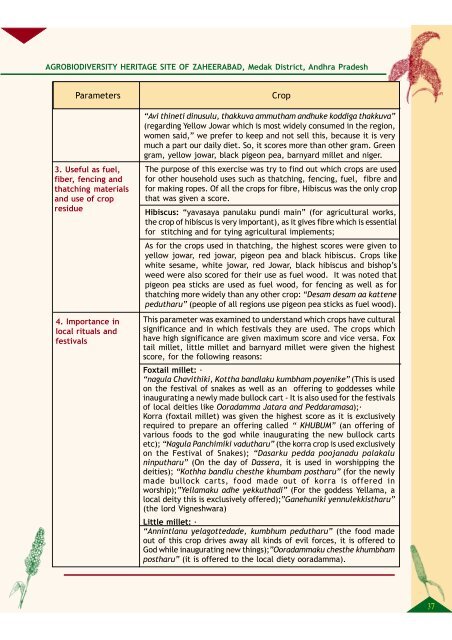Click for details - Deccan Development Society
Click for details - Deccan Development Society
Click for details - Deccan Development Society
Create successful ePaper yourself
Turn your PDF publications into a flip-book with our unique Google optimized e-Paper software.
AGROBIODIVERSITY HERITAGE SITE OF ZAHEERABAD, Medak District, Andhra Pradesh<br />
Parameters Crop<br />
3. Useful as fuel,<br />
fiber, fencing and<br />
thatching materials<br />
and use of crop<br />
residue<br />
4. Importance in<br />
local rituals and<br />
festivals<br />
“Avi thineti dinusulu, thakkuva ammutham andhuke koddiga thakkuva”<br />
(regarding Yellow Jowar which is most widely consumed in the region,<br />
women said,” we prefer to keep and not sell this, because it is very<br />
much a part our daily diet. So, it scores more than other gram. Green<br />
gram, yellow jowar, black pigeon pea, barnyard millet and niger.<br />
The purpose of this exercise was try to find out which crops are used<br />
<strong>for</strong> other household uses such as thatching, fencing, fuel, fibre and<br />
<strong>for</strong> making ropes. Of all the crops <strong>for</strong> fibre, Hibiscus was the only crop<br />
that was given a score.<br />
Hibiscus: “yavasaya panulaku pundi main” (<strong>for</strong> agricultural works,<br />
the crop of hibiscus is very important), as it gives fibre which is essential<br />
<strong>for</strong> stitching and <strong>for</strong> tying agricultural implements;<br />
As <strong>for</strong> the crops used in thatching, the highest scores were given to<br />
yellow jowar, red jowar, pigeon pea and black hibiscus. Crops like<br />
white sesame, white jowar, red Jowar, black hibiscus and bishop’s<br />
weed were also scored <strong>for</strong> their use as fuel wood. It was noted that<br />
pigeon pea sticks are used as fuel wood, <strong>for</strong> fencing as well as <strong>for</strong><br />
thatching more widely than any other crop: “Desam desam aa kattene<br />
pedutharu” (people of all regions use pigeon pea sticks as fuel wood).<br />
This parameter was examined to understand which crops have cultural<br />
significance and in which festivals they are used. The crops which<br />
have high significance are given maximum score and vice versa. Fox<br />
tail millet, little millet and barnyard millet were given the highest<br />
score, <strong>for</strong> the following reasons:<br />
Foxtail millet: ·<br />
“nagula Chavithiki, Kottha bandlaku kumbham poyenike” (This is used<br />
on the festival of snakes as well as an offering to goddesses while<br />
inaugurating a newly made bullock cart - It is also used <strong>for</strong> the festivals<br />
of local deities like Ooradamma Jatara and Peddaramasa);·<br />
Korra (foxtail millet) was given the highest score as it is exclusively<br />
required to prepare an offering called “ KHUBUM” (an offering of<br />
various foods to the god while inaugurating the new bullock carts<br />
etc); “Nagula Panchimiki vadutharu” (the korra crop is used exclusively<br />
on the Festival of Snakes); “Dasarku pedda poojanadu palakalu<br />
ninputharu” (On the day of Dassera, it is used in worshipping the<br />
deities); “Kothha bandlu chesthe khumbam postharu” (<strong>for</strong> the newly<br />
made bullock carts, food made out of korra is offered in<br />
worship);”Yellamaku adhe yekkuthadi” (For the goddess Yellama, a<br />
local deity this is exclusively offered);”Ganehuniki yennulekkistharu”<br />
(the lord Vigneshwara)<br />
Little millet: ·<br />
“Annintlanu yelagottedade, kumbhum pedutharu” (the food made<br />
out of this crop drives away all kinds of evil <strong>for</strong>ces, it is offered to<br />
God while inaugurating new things);”Ooradammaku chesthe khumbham<br />
postharu” (it is offered to the local diety ooradamma).<br />
37


